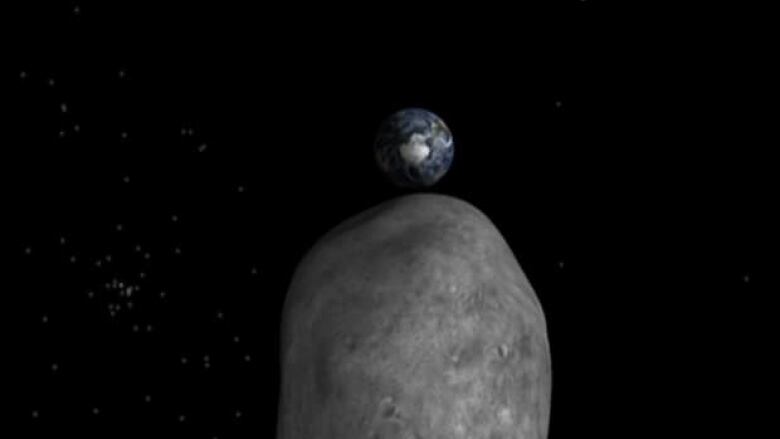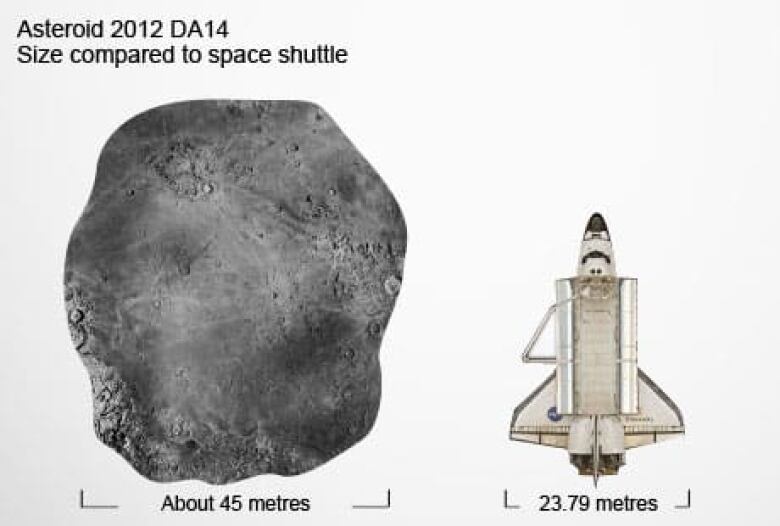Asteroid zips between Earth and satellites
Closest approach to Earth took place at 2:25 p.m. ET

A 130,000-tonne asteroid is continuing on its journey after zipping between the Earth and some of its satellites during a remarkably close flyby.
Aview of the fast-movingpoint of light in the night was broadcast live online fromthree observatories in Australialeading up to itsclosest approach Friday at 2:25 p.m. ET. Two of the observatories are run by amateur astronomers.
"The Milky Way is so clear you could almost touch it. It's a very, very good evening for doing what we're doing at the moment," said Auriol Heary, part-time astronomer and schoolteacher,from Gingin Observatory near Perth during a live NASA broadcast.
Paul Chodas,a scientist with NASA'sNear-Earth Object program, said he was amazed at how bright the asteroid appeared, given that it is only 45 metres in diameter. That isroughly the size of a jet plane or just slightly smaller than the Epcot geodesic dome at Walt Disney World Resort in Florida.
Theflyby came hoursafter a meteorstreaked over the skiesof Russian's Ural Mountains Friday morning, causing sharp explosions and injuring hundreds, many of them hurt by broken glass.
Chodassaid the Russian meteor had a diameter just a third that of DA14 and was unrelated to the asteroid.
"You can see what sort of destruction and shock wave a smaller asteroid can produce."
DA14approached the Earth from south to northat 28,100 km/h, or 7.82 kilometres per second.
It was just 27,700 kilometres above the Earth's surface one-tenth of the distance between the Earth and the moon when it made itsclosest approach at 2:25 p.m. ET Friday.
At that point, it wascloser to the Earth's surface than the man-made communications and weather satellites in geosynchronous orbitthe ones thatcomplete their trip around the Earth in 24 hours so they are alwaysover the same spot. Those satellitesare located in a ring about 35,800 kilometres above us.
The asteroidremained a comfortable distance away from the Earth itself, the International Space Station, which orbits just 386 kilometres above the Earth; and most other man-made satellites. No collisions were reported, norwas there ever any chance it would hit theEarth, NASA said.
Astronomerscontinue to observe the asteroid from around the world to get more information about its size, shape, how fast it is spinning and its makeup.
NASA said it plans to take radar images of the asteroid as it moves away fromthe Earthbetween Feb. 16 and 20 to get additional size and shape measurements, as well as more details about its motion so that its orbit can be calculated farther into the future.
NASA radar scientist Lance Benner said so far, DA14 seems to be rocky and appears to rotate once every six hours. Its brightness fluctuated a lot in previous measurements, soscientists think it's "pretty elongated."
DA14 was first detected last Feb. 23 by astronomers at La Sagra Sky Survey in Spain. It has an orbit around the sun similar to that of the Earth andhas been passingrelatively close by about twice a year. However, NASA says this time it's getting close enough that Earth's gravity will give it a significant nudge, altering its orbit so it travels more quickly around the sun completing its elliptical course in 317 days instead of 366. That means it will visit Earth less often. Chodas said it is next expected to make a reasonably close flyby in 2046 and there is a small possibility it could hit the Earth in 2080.
NASA estimates there are about 500,000 near-Earth asteroids about the size of DA14, and one of them will make a close encounter comparable to this one about every 40 years.
However, until recently, asteroids this small have been difficult to detect until after they have passed the Earth, said Curt Nason, an astronomer with the Saint John Astronomy Club in New Brunswick.
"We could have had a lot closer ones years ago," he said."They just couldn't see them."
On average, NASA estimates, an asteroid thesize of DA14 will actually hit the Earth about once every 1,200 years.













_(720p).jpg)


 OFFICIAL HD MUSIC VIDEO.jpg)
.jpg)



























































































